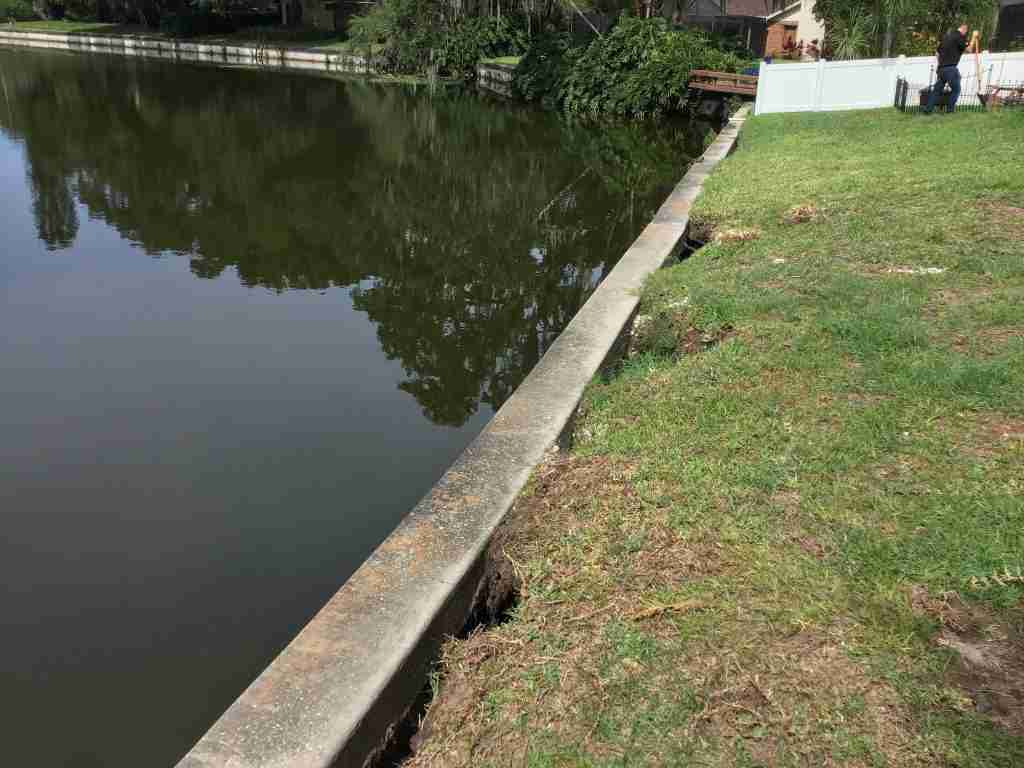Seawall construction in the State of Florida is an essential component in the protection against flooding and seawall erosion. However, when seawall erosion starts, the potential for serious issues can quickly become a reality. It is paramount to have a soil remediation company properly inspect the eroded soil around seawalls and ensure all constructed elements of the seawall are intact and safe.
Seawalls can withstand a lot of damage from coastal and ocean waters, but when water causes them to break down and erode, immediate repair is generally required. The cities in Florida that typically require seawall repair the most include:
- Naples
- Sarasota
- Cape Coral
- St. Petersburg
- Bonita Springs
- Clearwater
The Importance of Seawall Inspection
Seawall inspection is critical to the structural integrity of your seawall and to look for any evidence of drainage soils and seawall erosion. If there is evidence of drainage soils, they can move toward structures and pose a risk for human life. The seawall erosion inspection usually starts by exploring options to determine how to restrict the water inflow and the proper soil remediation method to use to stabilize your seawall.

This process is essential due to the tides and waves from the ocean that causes pressure on seawalls. Seawater can find a way to flow through cracks and defects in your seawall; therefore, those areas should be repaired as well. Seawalls are designed to keep seawater from flooding your home, but they do not last forever and should be inspected bi-annually at a bare minimum.
Why is Seawall Repair Required in Florida?
Heavy rains in areas of Florida such as Clearwater, Cape Coral, Bonita Springs, and other regions have the power and potential to create voids under your seawall and is one of the reasons why seawall repair is prevalent in this state. Innovative ground stabilizing methods using polyurethane foam injections are typically used to raise and level damaged seawalls caused by erosion. Poly foam replaces the soils behind the seawall, creating a long-term bond that strengthens the ground, eliminating deterioration and erosion.
Seawall Erosion Control, Cement vs Poly Foam Grouting
Advancements in the repair of seawall erosion have been very advantageous because of the use of cement grouting, which is the conventional method of repairing seawalls. Today, a new and innovative process quickly leaving cement grouting behind is a technique known as poly foam. Poly foam is considered more effective than cement grouting because it uses updated techniques instead of outdated practices that cement grouting still utilizes.
Cement grouting requires the use of heavy machinery, which can create havoc on landscaping and is a rather expensive procedure. It also takes longer for cement grouting to cure, whereas poly foam is cured and ready for service typically within hours of being injected.
Unlike cement grouting, polyurethane foams and resins fill voids and cracks better, making poly foam the best option and solution for proper seawall repair. Poly foam will not break down or deteriorate against the damage caused by coastal and saltwater issues. Poly foam can be installed with a minimum amount of disturbance or damage to your property.
The Benefits of Poly Foam
Poly foam repair is quicker than cement grouting for seawall erosion and restores your seawall for use in just a few hours. Also, it is more efficient at eliminating leaks that have been caused by hundreds or even thousands of gallons of water. The most significant advantage of using poly foam injections for repairing seawall erosion is that it is eco-friendly and safe for the environment.
Polyurethane grout injections are ideal for use in marinas and other areas with boat traffic as well as buildings and foundations located near seawater. Seawater contains salt, and saltwater is known to cause damage and corrosion. Cities such as Naples, St. Petersburg, and Sarasota have been experiencing the benefits of poly foam repair over the past few years. One of the reasons why poly foam is superior is due to its ability to disperse water as it fills voids and cracks.
Poly foam injections are the logical solution for most homeowners in Florida due to the efficiency of the installation process. The first phase of the polyurethane foam injection stabilizes the soils while the second phase expands and lifts the concrete. Since this process works by controlled flow rates and pressure, it relevels the plane of seawalls with amazing accuracy.
Poly Foam Offers Florida Homeowners Long-Term Solutions
With all the advantages of poly foam, another compelling reason is that the foam is that it is hydrophobic. This means leaks and wet conditions have no bearing on its ability to repair seawalls in Florida. It is also cleaner and more durable as a long-term solution for seawall repair in the State of Florida.
Poly foam provides excellent penetration and penetrates the smallest cracks. It has a set time far more sustainable than concrete. Since the set time is more rapid, repairs can be conducted more efficiently. The adhesive ability of poly foam guarantees that the bond is strong and will not break, making poly foam repair an excellent choice.
When it comes to long-term solutions for proper seawall repair, poly foam offers homeowners a more cost-effective option as opposed to conventional methods such as cement grouting and mudjacking techniques. With that being said, for proper seawall erosion issues quickly resolved with a proven method that last, contact Helicon today at (813) 567-1065 or simply fill out our online contact form.